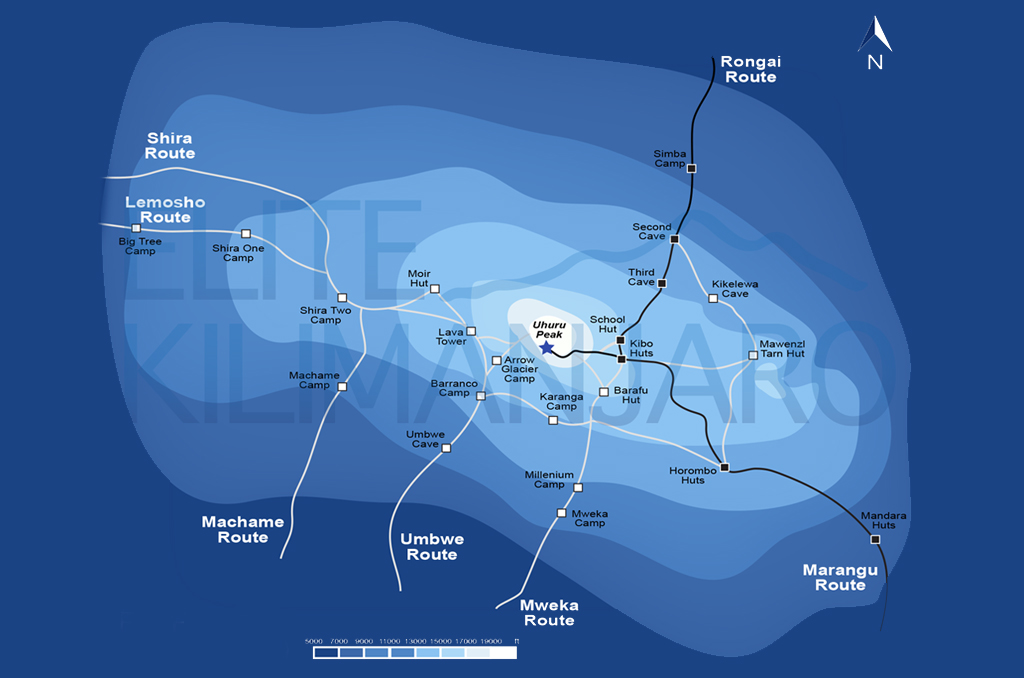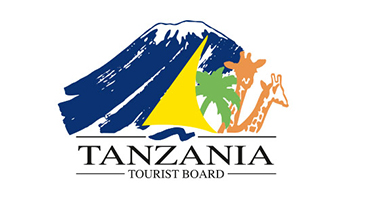Itinerary in glance:
- DAY 1: Drive to Kilimanjaro National Park Rongai Gate (Nale Moru), Hike to Simba Camp
- DAY 2: Hike Simba Camp to Second Cave
- DAY 3: Hike Second Cave to Third Cave
- DAY 4: Hike Third Cave to Kibo Hut
- DAY 5: Hike Kibo Hut to Summit, and down to Horombo Hut
- DAY 6: Hike Horombo Hut to trail head, drive to Moshi/Arusha
Route description:
The Rongai Route is thought to be one of the easiest Kilimanjaro routes. It typically has very little foot traffic compared to the other routes. The minimum duration for this trip is 6 days and that itinerary is described below.
Additional Acclimatization: You can add an additional day for acclimatization by taking a longer route east to Mawenzi Tarn on Day 2 and meeting back up with the trail at the Kibo Huts on Day 5. Elite Kilimanjaro recommends this option as it greatly increases your chances of success.
Full Itinerary:
Arrival Day
Pick up from Kilimanjaro International Airport and transfer to Arusha/Moshi town for your overnight. (Airport transfer and accommodation will be on your own account)
Day 1: Rongai Start Point (1996m) – Simba camp (2626m)
- Climbing time: 4 hours
- Distance: Approximately 6.7 km
- Environment: Forest (Montane)
Depart from Moshi/Arusha town to the Marangu park gate for registration. From Marangu park gate we travel to Naro Moru, north east Kilimanjaro, a further 68km and approximately 2 ½ hours on bad roads to the Rongai start point (1996m). Meet your guide and porters before you begin your hike from the Nale Moru village. The small winding path crosses maize fields before entering pine forest, and then climbs gently through a forest. The trail is not at all steep, but is rather a gentle hike through a beautiful country side. The first night’s camp is at Simba Camp (2 626m). The camp facilities include a public toilet and a wooden table with benches, but no hut.
Day 2: Simba camp (2626m) – Kikelewa Camp (3679m)
- Climbing time: 6 – 7 hours
- Distance: Approximately 11.8 km
- Environment: Moorlands
We hike from Simba camp up towards Kibo till 3 482m for lunch at First Caves, a distance of 5.8km. After lunch we continue trekking until reaching Kikelewa Camp at about 3679 metres. The views start to open up and you begin to feel you’re on a really big mountain! Water can be found in a obvious stream below the cave, although you might have to wander downhill a way to find a pool or two. Enjoy dinner and overnight at Kikelewa camp.
Day 3: Kikelewa Cave (3679m) – Mawenzi Tarn camp (4303m)
- Climbing time: 3 hours
- Distance: Approximately 3.7 km
- Environment: Moorlands
A short but steep climb up grassy slopes offers superb views of this wilderness area. The vegetation zone ends shortly before you reach your next camp at Mawenzi Tarn spectacularly situated beneath the towering spires of Mawenzi. Spend the afternoon acclimatizing and exploring the area.
Day 4: Mawenzi Tarn camp (4303m) – Kibo hut (4730m)
- Climbing time: 5 hours
- Distance: Approximately 9 km
- Environment: Alpine desert
After breakfast we head west and continue ascending on the east side of Kibo crossing the saddle between Mawenzi and Kibo taking 4 to 5 hours to reach Kibo Hut. The remainder of the day is spent resting in preparation for the final ascent, which begins around midnight. Overnight at Kibo hut.
Day 5: summit Attempt: Kibo hut (4730m) – Uhuru Peak (5895m) – Horombo hut (3705m)
- Climbing time: 7 to 8 hours to reach Uhuru Peak, 6 to 8 hours to descend to Horombo
- Distance: Approximately 5.4km ascent and 15 km descent
- Environment: Stone scree / ice-cap summit
You will rise around 23h20, and after some tea and biscuits you shuffle off into the night, and this is where the going really gets tough. The first section of the trail consists of a rocky path to the Hans Meyer Cave (5150m), also a good resting spot.
The path then zigzags up to Gillman’s point (5 681m), which is located on the crater rim. This section is very steep with a lot of stone scree, requiring a great physical and mental effort. This is probably the most demanding section of the entire route. Do the Kili shuffle and move slowly. From Gillmans Point you will normally encounter snow all the way up to Uhuru peak (5895m), the highest point in Africa.
Total exhilaration and satisfaction – you made it
Weather conditions on the summit will determine how long you will be able to spend, taking photographs, before the 3 hour descent back to Kibo hut. After a short rest at Kibo hot, you gather all your gear you left behind for the ascent and head down to Horombo hut (3 hours) for your overnight. The return to Horombo hut will seem surprisingly fast compared to the ascent. The total time spent walking on this day is around 14 hours, so be prepared for a very tough day. Later in the evening you enjoy your last dinner (with soft drinks and beer for sale at the camp office) on the mountain and a well-earned sleep, filled with memories and stirring emotions.
Day 6: Horombo hut (3705m) – Marangu Gate (1860m)
- Climbing time: 6 hours
- Distance: Approximately 19.7 km
- Environment: Moorland & Montane Forest
After breakfast you continue your descent (6 hours), passing the Mandara hut, down to the Marangu gate. It is strongly recommended not to pay your porters any tips until you and all your gear have reached the gate safely. Click here for more info on tips.
At Marangu gate you sign your name and details in a register. Here is also where successful climbers receive their certificates. Green certificates for those who reached Gillman’s Point (5685m) and Gold certificates for those who reached Uhuru Peak (5895m). Don't forget to tip your guides, cook and porters. You now drive back to Moshi/Arusha for your celebrations!!





